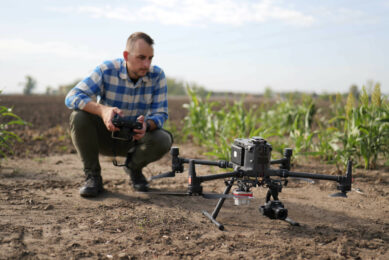Agritechnica launch pad for new drones

Although their use is essentially banned or severely restricted in many EU and non-EU countries, interest in spray drones continues to increase. At Agritechnica the market leading Chinese makers – DJI and XAG – faced new challengers designed and built in European countries including Turkey, Hungary, Germany and even Denmark.
DJI previews its largest spray drone
For the first time DJI Agriculture exhibited at Agritechnica in its own right, using the event to preview its latest models, which are expected to be on sale next year.
With its 40kg spraying or 50kg spreading payload the coaxial, dual-rotor Agras T50 is DJI’s largest Ag Drone. It is equipped with front and rear radars and dual binocular vision with terrain following. A high resolution FPV gimbal camera enable crop scanning and spraying.
Text continues below picture


New atomising nozzles, mounted beneath the rotors, can be set to produce from fine to very coarse droplets (50 to 500 microns), working at an 11m swath width. With two nozzles it can deliver flowrates of 16 litres/min or with four up to 24 litres/min. New solenoid valves quickly turn nozzle on and off for spot spraying and precision farming operations.
Also coming next year will be the Agras T25. Essentially a scaled down version of the T50, offering similar features, it has 25kg spreading payload and holds 20kg for spraying at similar flowrates.
Topxgun takes off
While not as well known as its leading Chinese counterparts Topxgun, based in the Jiangning Development Zone, has been producing drones for the past ten years.
Its current range comprises four models offering operating tank capacities from 15-50 litres. The smaller, 15 litre, FP150, which was new at the show, is equipped with eight, standard nozzles fitted in pairs under each rotor, while the existing 30 litre, FP300 uses 12.
Text continues below picture

Also making its debut at the event, was the larger 40 litre capacity FP500, which like the current and 50-litre FP 600, is fitted with air pressure atomisation nozzles, which don’t rotate and produce droplets from 50-500 micron and flowrates up to 20 litres/min.
All are controlled by the in-house designed and built controller, which now has a new Orchard Mode in the mapping software. Combined with the existing software, it provide quick and precise 3D route planning.
Turkish drone development
Spray applications by drone are increasing in Turkey with reports of large areas being covered in the past year. While its domestic manufacturer, Hattat Trackör, is probably best known for tractors, it also debuted a new drone, which was tucked away on its stand.
Developed in conjunction with its sister company, Hema, which specialises in developing components and control systems, the twin-rotor drone has a 25kg maximum take-off weight. The spray system provides 10 litre tank capacity and products are applied by a pair of conventional nozzles positioned under each rotor. It can apply flowrates up to 3.5 litres/min.
Text continues below picture

Joint venture delivers drones
Appia Drone Tech, is a Romanian and Hungarian joint venture working on digital developments, including drones, to modernise large scale agriculture.
Its latest model, on show at Agritechnica, is the four-rotor, ADT Falcon 50L. Priced at € 12,500 the drone has a 50-litre capacity tank and a maximum 90kg take-off weight. Two centrifugal, electrostatic nozzles produce droplets from between 50-200 microns in size and flowrates of up to 16 litres/min at a swath width of 11m.
The dual CPU flight controller uses and Android App, which is compatible with Google Maps and imported KML files.
Text continues below picture

Drone built on experience
Hungary-based ABZ Innovation used its years of experience of operating spray drones to create its own model, which it designed and tested in conjunction with the University of Gyor.
There is a choice of three versions of its four-rotor, L10 which is supplied with a 10 litre capacity tank and Lidar and RTK as standard. The L10 ESP has a 6-litre tank, which is designed to meet Spain’s requirements, while the L10 Pro comes with multi-band positioning and is plug and play ready for any EMLID RTK base station. Prices range from € 10,000 to € 11,000.
All use two CDA nozzles, which are mounted under a pair of rotors and can be adjusted to deliver 40 litres/ha at 1.5m swath width and up to 12 litres/ha at the maximum 6m. Droplet size can be adjusted from 40 to 1,000 microns.
There is also the option to fit a Trichogamma (parasitic wasp) spreading system for biological control.
Text continues below picture

Danish development
Denmark, which has some of Europe’s strictest spraying rules, does not permit applications by drone. However, this has not stopped domestic sprayer maker, Danfoil, teaming up to design a drone sprayer for a GUDP green development project.
The CropDrone stands out as not only being one of a few powered by a combustion engine, but also because it is equipped with Danfoil’s unique low volume, air assisted nozzles. As well as being tested to comply with 90% drift reduction, these are also designed to work at low volumes of 30-50 litres/ha.
“The ultimate aim is for the drone to live in the field. It will then fly out to scan the crop and transmit the data back to base. After this is processed it will receive a prescription map and fly again to apply spot treatments,” says Danfoil’s Martin Dyhrman Sørensen.
Text continues below picture

Fluktor – the flying tractor
Fluktor takes its name from joining the German word ‘Flug’ (fly) and English ‘Tractor’ to make Flying Tractor. Not yet a year old, the German firm displayed its first spray and spread drone in Agritechnica’s start up area.
Designed and built in Germany, the new CS50 Agricultural Drone has a 60kg take-off weight and comes with remote control and everything required for operations, including free mission control Windows software. It is designed as an open drone carrier system, which can be equipped with various attachments, including sprayers and spreader.
At Agritechnica it was displayed fitted with a 30 litre capacity Agrotop sprayer, which is already JKI approved. This operates at 3 bar and delivers a flowrate of up to 12 litres/min through 04 nozzles mounted on tubes beneath each of the four rotors.
Text continues below picture


Join 17,000+ subscribers
Subscribe to our newsletter to stay updated about all the need-to-know content in the agricultural sector, two times a week.



